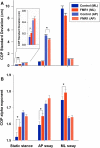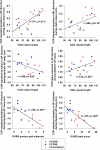Static and dynamic postural control deficits in aging fragile X mental retardation 1 (FMR1) gene premutation carriers
- PMID: 30665341
- PMCID: PMC6341725
- DOI: 10.1186/s11689-018-9261-x
Static and dynamic postural control deficits in aging fragile X mental retardation 1 (FMR1) gene premutation carriers
Abstract
Background: Individuals with premutation alleles of the fragile X mental retardation 1 (FMR1) gene are at risk of developing fragile X-associated tremor/ataxia syndrome (FXTAS) during aging. Characterization of motor issues associated with aging in FMR1 premutation carriers is needed to determine neurodegenerative processes and establish new biobehavioral indicators to help identify individuals at greatest risk of developing FXTAS.
Methods: We examined postural stability in 18 premutation carriers ages 46-77 years and 14 age-matched healthy controls. Participants completed a test of static stance and two tests of dynamic postural sway on a force platform to quantify postural variability and complexity. CGG repeat length was measured for each premutation carrier, and MRI and neurological evaluations were conducted to identify carriers who currently met criteria for FXTAS. Of the 18 premutation carriers, seven met criteria for definite/probable FXTAS (FXTAS+), seven showed no MRI or neurological signs of FXTAS (FXTAS-), and four were inconclusive due to insufficient data.
Results: Compared to controls, premutation carriers showed increased center of pressure (COP) variability in the mediolateral (COPML) direction during static stance and reduced COP variability in the anterior-posterior (COPAP) direction during dynamic AP sway. They also showed reductions in COPML complexity during each postural condition. FXTAS+ individuals showed reduced COPAP variability compared to FXTAS- carriers and healthy controls during dynamic AP sway. Across all carriers, increased sway variability during static stance and decreased sway variability in target directions during dynamic sways were associated with greater CGG repeat length and more severe neurologically rated posture and gait abnormalities.
Conclusion: Our findings indicate that aging FMR1 premutation carriers show static and dynamic postural control deficits relative to healthy controls implicating degenerative processes of spinocerebellar and cerebellar-brainstem circuits that may be independent of or precede the onset of FXTAS. Our finding that FXTAS+ and FXTAS- premutation carriers differed on their level of intentional AP sway suggests that neural mechanisms of dynamic postural control may be differentially impacted in patients with FXTAS, and its measurement may be useful for rapidly and precisely identifying disease presence and onset.
Keywords: Cerebellum; FMR1gene premutation allele; Fragile X mental retardation 1 (FMR1) gene; Fragile X-associated tremor/ataxia syndrome (FXTAS); Postural control.
Conflict of interest statement
Ethics approval and consent to participate
All study procedures were approved by the Institutional Review Boards at the UT Southwestern Medical Center and Children’s Hospital of Dallas. Written consent was obtained from each adult individual before the administration of test and evaluations.
Consent for publication
Not applicable.
Competing interests
Dr. Wang serves as a co-investigator on an investigator-initiated award studying Phelan-McDermid Syndrome from Novartis. Dr. Mosconi serves as a consultant on this award. The other authors declare that they have no competing interest.
Publisher’s Note
Springer Nature remains neutral with regard to jurisdictional claims in published maps and institutional affiliations.
Figures



Similar articles
-
Characterization and Early Detection of Balance Deficits in Fragile X Premutation Carriers With and Without Fragile X-Associated Tremor/Ataxia Syndrome (FXTAS).Cerebellum. 2015 Dec;14(6):650-62. doi: 10.1007/s12311-015-0659-7. Cerebellum. 2015. PMID: 25763861
-
Preliminary evidence of an effect of cerebellar volume on postural sway in FMR1 premutation males.Genes Brain Behav. 2015 Mar;14(3):251-9. doi: 10.1111/gbb.12204. Epub 2015 Mar 25. Genes Brain Behav. 2015. PMID: 25689687
-
Fragile X-associated tremor/ataxia syndrome: influence of the FMR1 gene on motor fiber tracts in males with normal and premutation alleles.JAMA Neurol. 2013 Aug;70(8):1022-9. doi: 10.1001/jamaneurol.2013.2934. JAMA Neurol. 2013. PMID: 23753897 Free PMC article.
-
Update on the Clinical, Radiographic, and Neurobehavioral Manifestations in FXTAS and FMR1 Premutation Carriers.Cerebellum. 2016 Oct;15(5):578-86. doi: 10.1007/s12311-016-0799-4. Cerebellum. 2016. PMID: 27287737 Free PMC article. Review.
-
Involvement of the Cerebellar Peduncles in FMR1 Premutation Carriers: A Pictorial Review of Their Anatomy, Imaging, and Pathology.Int J Mol Sci. 2025 May 6;26(9):4402. doi: 10.3390/ijms26094402. Int J Mol Sci. 2025. PMID: 40362640 Free PMC article. Review.
Cited by
-
Optimal time lags from causal prediction model help stratify and forecast nervous system pathology.Sci Rep. 2021 Oct 22;11(1):20904. doi: 10.1038/s41598-021-00156-2. Sci Rep. 2021. PMID: 34686679 Free PMC article.
-
Delineating the Relationships Between Motor, Cognitive-Executive and Psychiatric Symptoms in Female FMR1 Premutation Carriers.Front Psychiatry. 2021 Dec 3;12:742929. doi: 10.3389/fpsyt.2021.742929. eCollection 2021. Front Psychiatry. 2021. PMID: 34925088 Free PMC article.
-
Cerebellar-cortical function and connectivity during sensorimotor behavior in aging FMR1 gene premutation carriers.Neuroimage Clin. 2020;27:102332. doi: 10.1016/j.nicl.2020.102332. Epub 2020 Jul 2. Neuroimage Clin. 2020. PMID: 32711390 Free PMC article.
-
Aging with Autism Departs Greatly from Typical Aging.Sensors (Basel). 2020 Jan 20;20(2):572. doi: 10.3390/s20020572. Sensors (Basel). 2020. PMID: 31968701 Free PMC article.
-
Low normal FMR1 genotype in older adult women: Psychological well-being and motor function.Arch Gerontol Geriatr. 2022 Nov-Dec;103:104789. doi: 10.1016/j.archger.2022.104789. Epub 2022 Aug 12. Arch Gerontol Geriatr. 2022. PMID: 35981426 Free PMC article.
References
Publication types
MeSH terms
Substances
Supplementary concepts
Grants and funding
LinkOut - more resources
Full Text Sources
Medical
Miscellaneous

